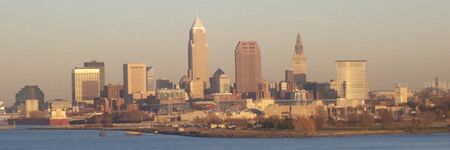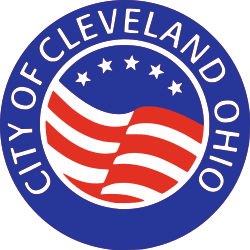Cleveland OH: Difference between revisions
Created page with "{{Infobox municipality |municipality= City |established = 22 July 1796 |image = Cleveland photomontage 2016.jpg |image_caption = Clockwise, from top: Downtown Cleveland sk..." |
No edit summary |
||
| Line 1: | Line 1: | ||
{{Infobox municipality | {{Infobox municipality | ||
|image=Cleveland OH.jpg | |||
|image_caption=Skyline | |||
|image = Cleveland | |image_seal=Seal of Cleveland, Ohio.svg | ||
|image_caption = | |municipality=City | ||
|image_seal = Seal of Cleveland, Ohio.svg | |established=July 22, 1796 | ||
|area = 82.49 | |area=82.49 | ||
|elevation = 653 | |elevation=653 | ||
|population = 372624 | |population=372624 | ||
|website = https://www.thisiscleveland.com/ | |website=https://www.thisiscleveland.com/ | ||
|timezone = EST | |timezone=EST | ||
|description= | |description=Cleveland is a major city in the U.S. state of Ohio, and the county seat of Cuyahoga County. It is located along the southern shore of Lake Erie, across the U.S. maritime border with Canada and approximately 60 miles (100 kilometers) west of the Ohio-Pennsylvania state border. | ||
Cleveland is a major city in the U.S. state of Ohio, and the county seat of Cuyahoga County. It is located along the southern shore of Lake Erie, across the U.S. maritime border with Canada and approximately 60 miles (100 kilometers) west of the Ohio-Pennsylvania state border. | |||
}} | }} | ||
The largest city on Lake Erie and one of the most populous urban areas in the country, Cleveland anchors the Greater Cleveland Metropolitan Statistical Area (MSA) and the Cleveland–Akron–Canton Combined Statistical Area (CSA). The CSA is the most populous combined statistical area in Ohio and the 17th largest in the United States, with a population of 3,633,962 in 2020. The city proper, with a 2020 population of 372,624, ranks as the 54th-largest city in the U.S., as a larger portion of the metropolitan population lives outside the central city. The seven-county metropolitan Cleveland economy, which includes Akron, is the largest in the state. | The largest city on Lake Erie and one of the most populous urban areas in the country, Cleveland anchors the Greater Cleveland Metropolitan Statistical Area (MSA) and the Cleveland–Akron–Canton Combined Statistical Area (CSA). The CSA is the most populous combined statistical area in Ohio and the 17th largest in the United States, with a population of 3,633,962 in 2020. The city proper, with a 2020 population of 372,624, ranks as the 54th-largest city in the U.S., as a larger portion of the metropolitan population lives outside the central city. The seven-county metropolitan Cleveland economy, which includes Akron, is the largest in the state. | ||
Latest revision as of 19:44, April 5, 2022
- Members
Cleveland is a major city in the U.S. state of Ohio, and the county seat of Cuyahoga County. It is located along the southern shore of Lake Erie, across the U.S. maritime border with Canada and approximately 60 miles (100 kilometers) west of the Ohio-Pennsylvania state border.
Activities

|
Smart Replicable Solutions to Water-Energy Nexus Challenges | |
| The goal of this action cluster is to provide innovative solutions for managing drinking water, wastewater, stormwater and source water resources efficiently and effectively. | ||

|
Smart Water Technologies | |
| The goal of this action cluster is to provide innovative solutions for managing drinking water, wastewater, stormwater and source water resources efficiently and effectively.
The smart decisions that balance energy usage with desired water quality and quantity will be supported through the development of cloud-based analytics that is driven with the “Big Data” from distributed array of environmental sensors. These “Internet of Things (IOT)” environmental sensors will be used to both monitor and control the environment. The new data will be supplemented with the data from the existing infrastructure such as SCADA historian databases and meter data. Additional data needs will be examined carefully to reduce their impact on operations. For example, water meter data is usually collected on a daily basis to prolong the battery life whereas the same data may be needed at five-minute intervals to generate an accurate demand picture. Innovative approaches that provide additional data through low-cost sensing and citizen participation will be explored. | ||

|
Efficient and Connected Off-Road Machinery | |
| This white paper explores both global and U.S. market trends that are driving new thinking, designs and technologies in Off-Road machinery. | ||
Details
The largest city on Lake Erie and one of the most populous urban areas in the country, Cleveland anchors the Greater Cleveland Metropolitan Statistical Area (MSA) and the Cleveland–Akron–Canton Combined Statistical Area (CSA). The CSA is the most populous combined statistical area in Ohio and the 17th largest in the United States, with a population of 3,633,962 in 2020. The city proper, with a 2020 population of 372,624, ranks as the 54th-largest city in the U.S., as a larger portion of the metropolitan population lives outside the central city. The seven-county metropolitan Cleveland economy, which includes Akron, is the largest in the state.
Cleveland was founded in 1796 near the mouth of the Cuyahoga River by General Moses Cleaveland, after whom the city was named. It grew into a major manufacturing center due to its location on both the river and the lake shore, as well as numerous canals and railroad lines. A port city, Cleveland is connected to the Atlantic Ocean via the Saint Lawrence Seaway. The city's economy relies on diversified sectors such as manufacturing, financial services, healthcare, biomedicals, and higher education. The gross domestic product (GDP) for the Greater Cleveland MSA was $135 billion in 2019. Combined with the Akron MSA, the seven-county Cleveland–Akron metropolitan economy was $175 billion in 2019, the largest in Ohio, accounting for 25% of the state's GDP.
Designated as a "Gamma -" global city by the Globalization and World Cities Research Network, the city's major cultural institutions include the Cleveland Museum of Art, the Cleveland Museum of Natural History, the Cleveland Orchestra, Playhouse Square, and the Rock and Roll Hall of Fame. Known as "The Forest City" among many other nicknames, Cleveland serves as the center of the Cleveland Metroparks nature reserve system. The city's major league professional sports teams include the Cleveland Browns, the Cleveland Cavaliers, and the Cleveland Guardians.



